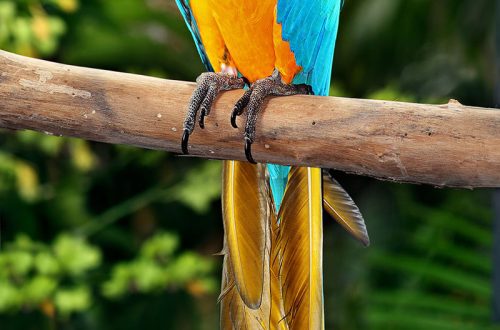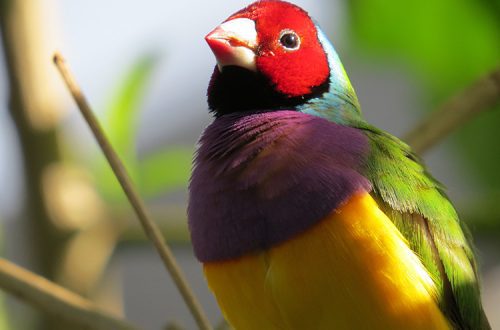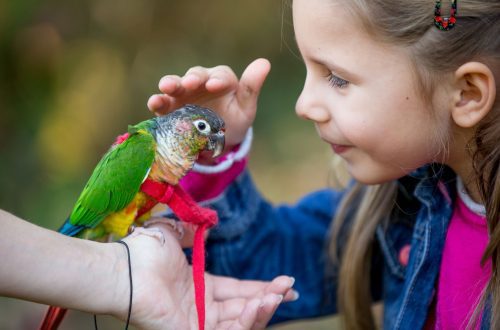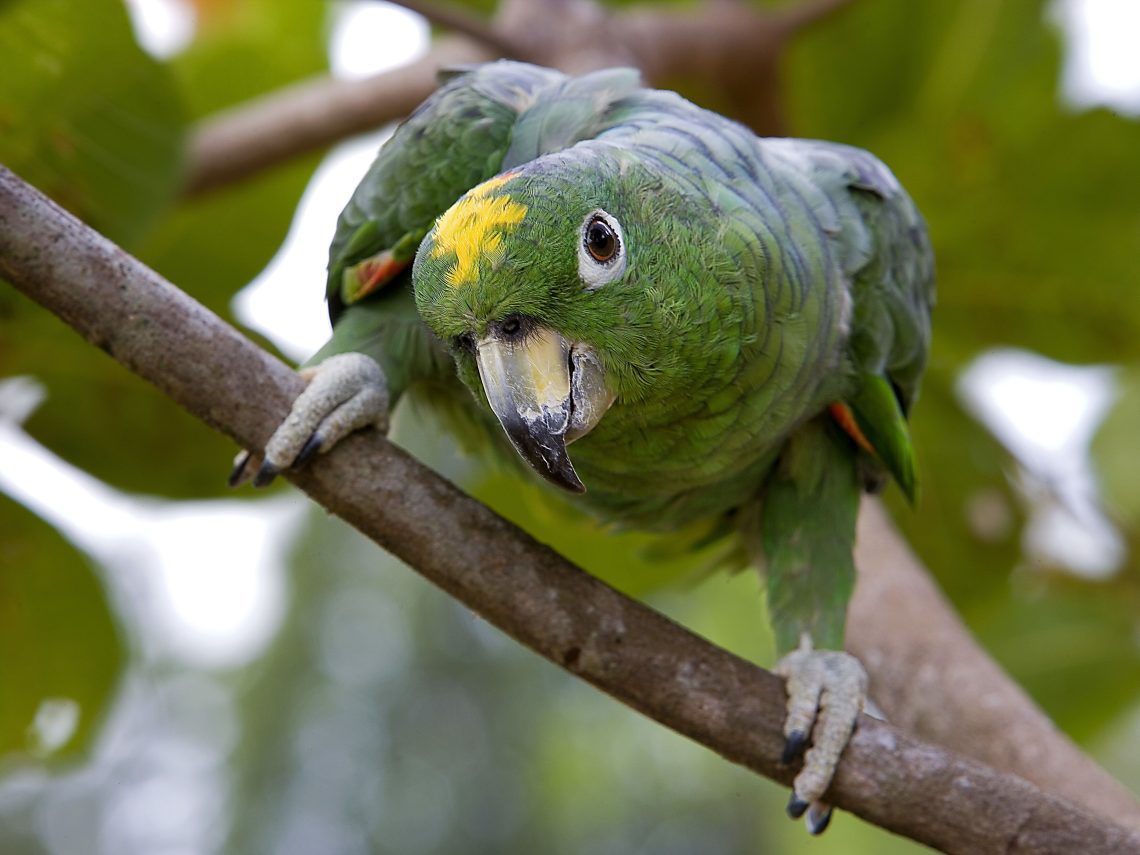
Amazon parrot species
Amazon parrots are very interesting and talented birds. We learned about the features of their behavior, food preferences and their attitude towards a person in the article. Amazons. It’s no secret that the variety of species of these smart and bright creatures is numerous. Each parrot has its own zest: whether it is an external difference from relatives, a feature of a habitat in nature or a talent for singing, talking, communicating with people.
The individuality of the Amazons is manifested not only between subspecies, but within any species, each bird is a personality that can be strikingly different from its relatives.
In terms of intelligence, Amazon parrots are second only to the African gray parrot, they are not difficult to tame, as the birds themselves are drawn to humans.
A happy bird living in peace and love with its owner is able to impress any person with affection, devotion and kindness. The relationship between the Amazon and its owner is very deep and touching, the bird “breathes” with its friend, it becomes an integral part of a person’s life without which not a single event will be left without attention.
In order to get to know the Amazons better, let’s look at each species in as much detail as possible. It will not only be easier for you to navigate when choosing the type of parrot, but an understanding of the versatility of these birds, unusualness and value will come.
In different classifications, the number of species of parrots can range from 26 to 32. We have listed 30 species, including the recently discovered: Amazona kawalli and mentioned two already extinct: Amazona violacea and Amazona martinica.
Contents
- Amazon muller
- Royal (St. Vincent) Amazon
- imperial amazon
- Luxury Amazon
- Festival (festive, blue-bearded) Amazon
- White-fronted (red-eyed) Amazon
- Blue-fronted (red-shouldered) Amazon
- Blue-capped (lilac-headed) Amazon
- Blue-cheeked (orange-winged) Amazon
- blue-faced
- Wine-breasted (wine-red, pigeon) Amazon
- Red-faced (yellow-cheeked) Amazon
- red-throated amazon
- Red-tailed (Brazilian) Amazon
- yellow-necked amazon
- Yellow-shouldered (yellow-winged) Amazon
- Yellow-bridled (Yucatan) Amazon
- yellow-headed amazon
- Black-eared (Dominican) Amazon
- green-cheeked amazon
- Soldier Amazon
- yellow-fronted amazon
- Puerto Rican Amazon
- Cuban (white-headed) Amazon
- Jamaican black-billed Amazon
- Jamaican yellow-billed Amazon
- Venezuelan (orange-winged) Amazon
- Tucuman Amazon
- Amazon Cavalla, white-faced
- red-browed amazon
- †Purple (Guadalupe) Amazon
- †Martinique Amazon
Amazon muller
(Amazona farinosa – “flour Amazon”)
Habitat: humid tropical jungles of Central and South America, in northern Brazil.
The largest species of Amazons, the bird’s body size is 38-42 cm, weight 550-700 g. There is an outward resemblance to Amazona ochrocephala oratrix, a yellow-headed subspecies of the Surinamese Amazon.
The color of the parrot is green with a gray-white “powder”, which gives it a smoky hue and the effect of being powdered with flour. A yellow spot can be observed on the front of the head in some individuals. On the back of the head, the feathers are decorated with a wide gray-violet border, the eye rings are pure white. The fold of the wings is red-olive or red-yellow, the ends of the flight feathers are purple-white.
There is no sexual dimorphism.
For life in captivity, birds need spacious enclosures and a balanced diet, taking into account the individual needs of this species (due to malnutrition, parrots often suffer from a lack of vitamin A). They gain weight very quickly and their tendency to obesity adversely affects the general condition of the bird.
It is very important to maintain constant physical activity in Amazons. Muller’s Amazons are very noisy birds, they easily become attached to humans. During the mating season, they can become aggressive towards other people and birds. The parrot will jealously protect its owner from contact with others and demand undivided attention.
The Amazon Muller species is divided into 5 subspecies, some sources indicate 3, the reason for the disagreement among taxonomists will become clear below:
- Amazona farinosa farinosa is the nominate subspecies with a large yellow head patch.
- Amazona farinosa inornata is larger than the nominal subspecies, yellow plumage is almost absent from the green head.
- Amazona farinosa chapmani – differ from inornata only in large size, so some ornithologists generalize them into one subspecies – inornata.
- Amazona farinosa virenticeps – the color of the entire body of this subspecies is yellow-green, and the forehead and frenulum are green with a slight blue tint.
Amazona farinosa guatemalae – in English sources you can find the statement that this parrot is a blue-headed Amazon. The upper part of the head is blue, but gradually, turning to the back, the color becomes gray. The plumage on the fold of the wing is yellow-green in color. Parrots are similar to subspecies virenticeps, except for the color of the head.
Royal (St. Vincent) Amazon
(Amazona guildingii)
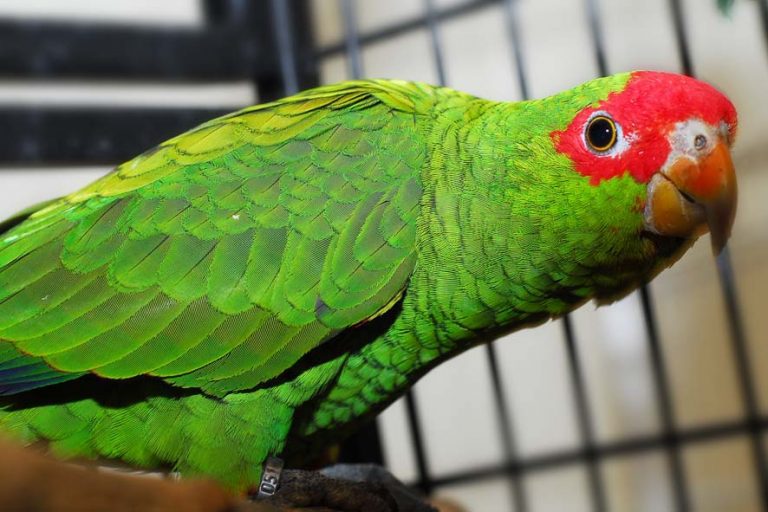
Habitat: Tropical rainforests of St. Vincent Island.
The color of the parrot is very beautiful: green and olive tint on golden brown back feathers. The head is orange, the forehead and front of the head are white with a smooth transition to yellow. The cheeks and the area around the ears are blue-violet, the belly of the parrot is golden brown.
By the end of the 500th century, due to illegal trapping of birds, hunting for them and the destruction of their habitat, the number of individuals in the population was only about XNUMX birds. Today this species is protected by CITES.
imperial amazon
(Kaiser’s Amazon) (Amazona imperialis)
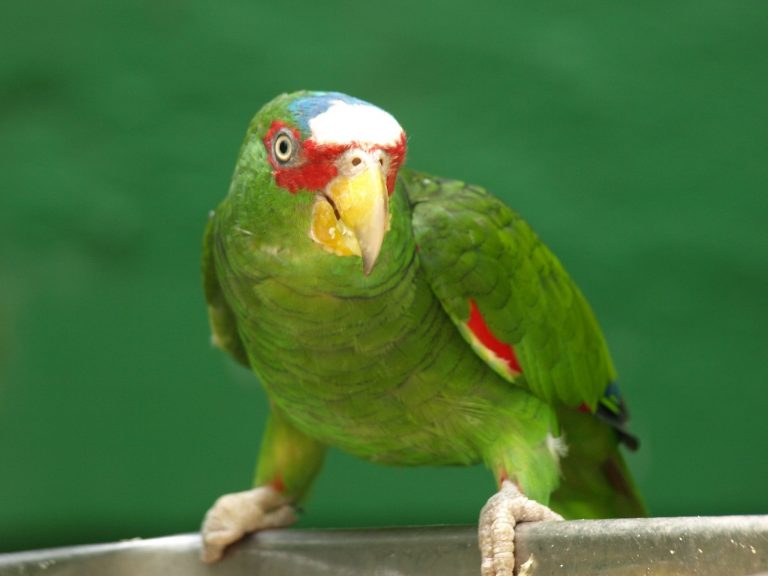
Habitat: tropical forests and mountains of the Lesser Antilles and Dominican Islands.
The largest species of Amazons, the body size reaches 47 cm. The main color of the parrot is green with a dark plumage frame, the forehead and cheeks are purple-brown, and the ears are red-brown. The head, neck and abdomen are purple.
In the sky, the soaring imperial amazon is very similar to a bird of prey: its impressive size, rare wing beats and the ability to stay on air currents for a long time can mislead any observer.
There is no sexual dimorphism in this parrot species. Imperial Amazons nest in hollows of trees, offspring in the form of one chick appears only once every two years.
Parrots are able to scream very loudly with different intonations, which are most similar to the sounds made by pipes.
A very rare species, on the verge of extinction. At the end of the twentieth century, the population consisted of only 100 individuals. This species has suffered from uncontrolled illegal trapping and hunting, massive deforestation and severe hurricanes – destroying their habitat. Imperial Amazons are protected by CITES.
Luxury Amazon
(Amazon search)
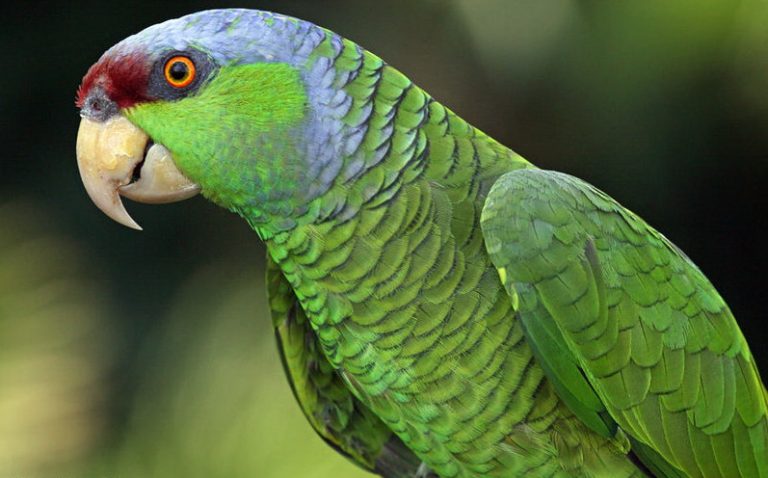
Habitat: araucaria forests of southern Brazil, seasonal migrations to the northeast of Argentina and Paraguay.
A green bird with red plumage around the eyes, on the forehead, on the folds of the wings and on the flight feathers of the first order. The edges of the flight feathers are blue. In females, the number of red feathers on the primary wings is no more than 6 pieces, the edges are green.
A rare bird due to the destruction of the natural habitat and illegal capture by poachers. Thanks to the protection of the Brazilian government, the number of individuals in the population increased to 1997 birds by 16000.
Festival (festive, blue-bearded) Amazon
(Festive Amazon)
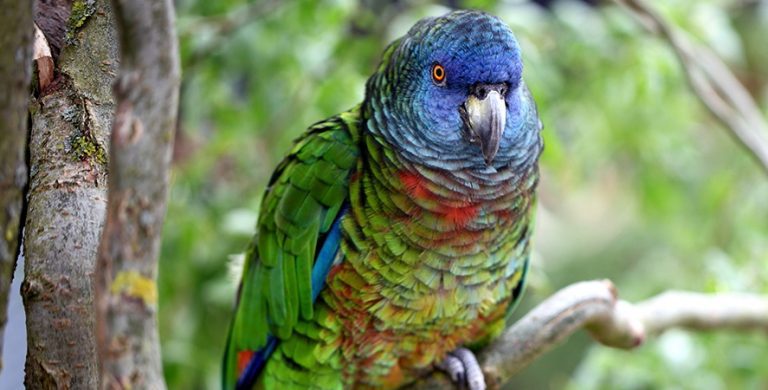
Habitat: Brazil, Ecuador, Colombia, Venezuela, Amazon and Orinoco forests.
The bird is dark green in color with a thin black border in the upper part of the body. On the forehead there is a red stripe that stretches to the eyes, the bridle is dark red, the lower part of the back is scarlet. A blue-blue stripe from the eyes, slightly “touching” the cheeks, goes to the throat. The chin and area above the eyes are decorated with blue plumage. The first order flight feathers are green and edged with yellow, while the second order flight feathers are blue-violet.
The festival Amazon includes two subspecies:
- Amazona festiva festiva is the nominal subspecies.
- Amazona festiva bodini – more saturated shades of plumage, brighter yellow in color, almost black bridle, and a purple stripe above the eyes.
A quick-witted parrot that can be tamed and taught conversation and tricks.
Despite the fact that this species is classified as a centenarian, nevertheless, the life expectancy of a bird is only 24,5 years.
White-fronted (red-eyed) Amazon
(Amazon albifron)
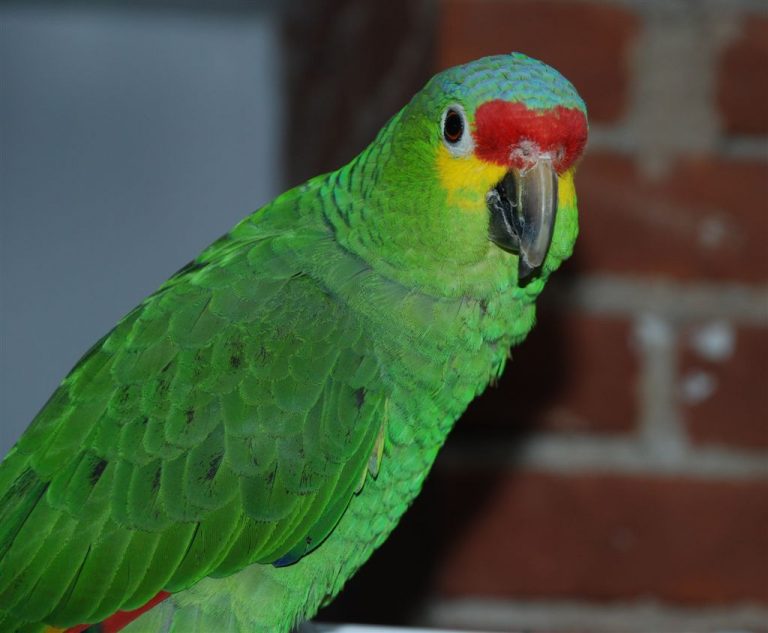
Habitat: from the tropical rainforests of Central America to the north of Costa Rica. The peculiarity of the white-fronted Amazon in its size is 26 cm, weight 370 grams – this is the smallest type of Amazon.
The bird is green in color, with a white spot on the forehead, the eyes are framed by red “glasses”, there are some blue feathers on the back of the head. In chicks, the white spot is much smaller and casts yellow, the red edging is also more sparse and pale. Males have a red stripe on their wings, females have red-brown eyes. Flight wings are blue, belly and undertail are yellow-green.
Life expectancy is about 50 years. This type of Amazon is very popular among bird lovers. Parrots are unpretentious, although they are sensitive to low temperatures, like all Amazons.
Amazona albifrons is divided into three subspecies:
- Amazona albifrons albifrons, the white-fronted Amazon is the nominal subspecies.
- Amazona albifrons nana, Small white-fronted Amazon – slightly smaller than the nominal subspecies, no larger than 24 cm.
- Amazona albifrons saltuensis, the Sonorian white-fronted Amazon, is distinguished by its blue-green plumage.
Blue-fronted (red-shouldered) Amazon
(Summer Amazon)
Habitat: dense tropical forests of Argentina, Brazil, Bolivia and Paraguay.
Green birds with a blue spot on the forehead, which, due to the heterogeneity of shades in each individual, makes it possible to distinguish any parrot in the flock. Throat, cheeks and nape yellow. There is no sexual dimorphism in this species.
Amazona aestiva is divided into two subspecies: Amazona aestiva aestiva (Linnaeus, 1758), which is the nominate Amazona aestiva xanthopteryx (Berlepsch, 1896).
The nominal subspecies is characterized by red feathers at the base of the wing, and the yellow-shouldered Amazon in the same place on the wing fold is decorated with yellow feathers with rare red patches.
Blue-fronted Amazons are long-lived, the age of birds in captivity can reach 90 years.
A popular parrot species for home keeping, although captive breeding is very rare. Parrots are quite demanding on conditions. Even in a spacious and comfortable aviary, birds can get used to the environment for more than one year, but if they like the place, then in a few years you will witness the repeated appearance of offspring from your pair of parrots.
Birds easily parody the sounds and speech of people, they are quite talented in various kinds of tricks. They can always recognize their owner in the crowd. Red-shouldered Amazons are able to make cutting sounds, so it is better to train the bird. Thanks to upbringing, you will hear such cries from them very rarely.
Blue-fronted Amazons are sensitive to air temperatures below 12C. Cold air is detrimental to these birds, even for a short time.
Blue-capped (lilac-headed) Amazon
(finschi rider)
Habitat: coniferous and oak forests, tropical jungles of the western part of Mexico.
The color is green, the forehead and front of the head are violet-brown, the feathers of the head have a lilac-blue tint, which passes from the back of the head to the neck – the bird has a hood on its head, the belly is lemon-colored. The rings around the eyes are grey. Flight feathers of the second order are blue-violet, the first five feathers have red spots.
Due to frequent raids on banana plantations, they are considered pests.
Since 2004, this species has been protected by CITES. The population of blue-capped Amazons consists of 7-000 individuals.
Blue-cheeked (orange-winged) Amazon
(Amazona dufresnian)
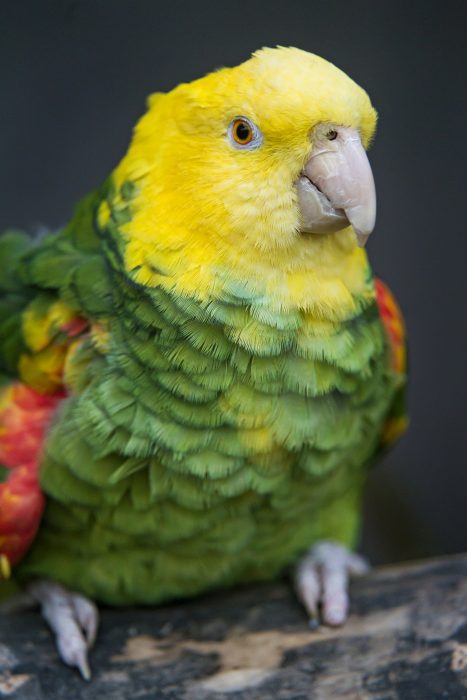
Habitat: mangroves, tropical jungles and river banks in the northeast of Brazil, in Suriname, Guyana, southern Venezuela.
A green parrot with a black border on the upper body. The cheeks and throat are bluish-blue, the forehead and lore are yellow. There is an orange stripe along the wing.
A very rare species.
blue-faced
(Sentlusian, multi-colored) Amazon (Amazona versicolor)

Habitat: slopes of humid mountain forests of the Lesser Antilles (St. Lucia).
A large bird (43 cm), the main color is green. The plumage of the head, cheeks and ears is blue, the forehead is blue-violet. In some bluefaces, a red spot can be seen on the chest. Flight feathers of the first order are blue-violet, the second order are green with blue-violet edges. The extreme feathers are decorated with a red spot.
A species of Amazons that is on the verge of extinction due to many years of uncontrolled hunting of these birds, the extermination of their natural habitat. Unfortunately, by the end of the 400th century, the population was reduced to 1980 birds. Since XNUMX, the blue-faced Amazon has been the national bird of the island. Saint Lucia.
Wine-breasted (wine-red, pigeon) Amazon
(Amazona vinacea)
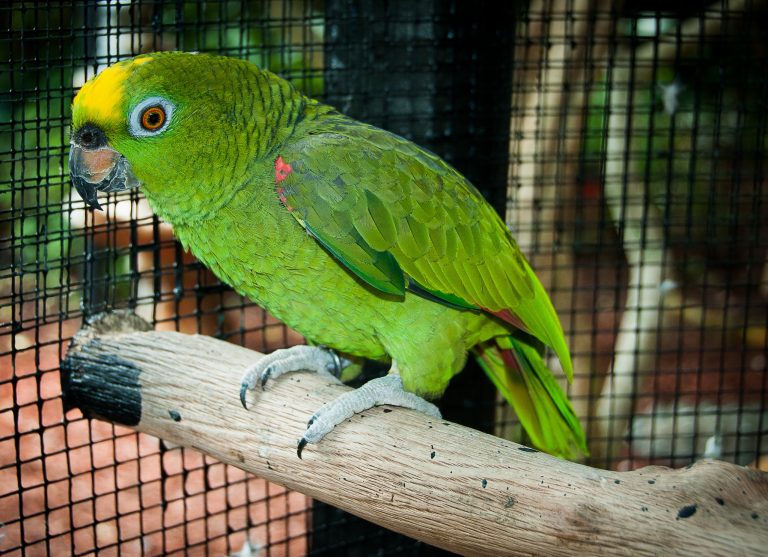
Habitat: pine forests, humid tropical jungles, mountain slopes and forests of the southwestern part of Brazil, Paraguay and Argentina.
The main color of the plumage is green, a border of black feathers runs along the head and back. The beak and bridle are red, the throat and abdomen are decorated with wine-red feathers with black and blue edging.
Wine-breasted parrots are on the verge of extinction for the same reasons as other types of parrots: poaching and loss of natural habitat due to deforestation for agricultural land.
Red-faced (yellow-cheeked) Amazon
(Amazona autumnalis)
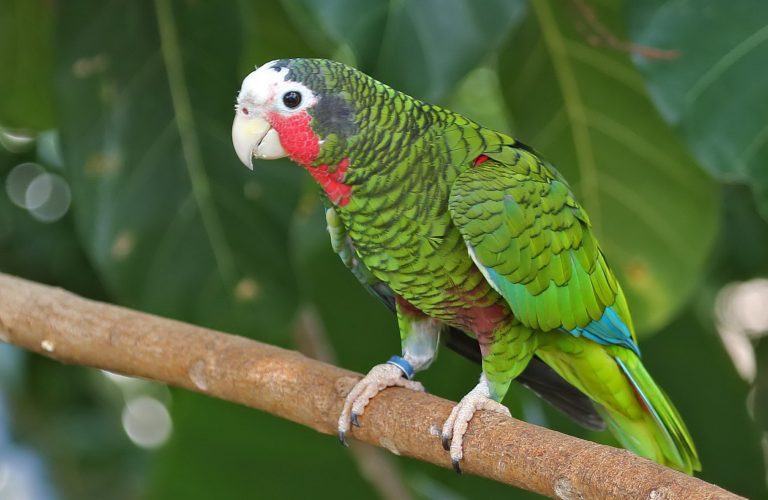
Habitat: tropical forests of southern Ecuador, South America and Eastern Mexico.
Very bright and beautiful bird. The forehead is painted red, the cheeks are yellow, the parietal part has a light purple tint with a black border. Around the eyes, dark feathers, much like eyelashes, surround them with a white ring that highlights the orange eyes. There is no sexual dimorphism.
The red-faced Amazon includes four subspecies:
- Amazona autumnalis autumnalis is the nominal subspecies.
- Amazona autumnalis diadema – characterized by a crimson hue of the forehead and cheeks with a blue tint.
- Amazona autumnalis salvini – this subspecies has green-yellow cheeks, and the inner lateral tail plumage is red. Fairly pale in color compared to the nominal subspecies. Not very popular with bird owners.
- Amazona autumnalis lilacina – the parrot is similar to the nominal subspecies, but the color is much darker.
The red-faced Amazon is a popular pet, he is talented and easily trained to speak. One of the disadvantages of this species is loudness: birds like to make noise and bite.
red-throated amazon
(Amazona arausiaca)

Habitat: alpine forests, mangroves of the Lesser Antilles and southeast Brazil.
The plumage is green, the front of the head, including the cheeks and neck, is blue-violet, along the neck there is a strip of red feathers, its size can be of different sizes, in some birds it covers most of the chest.
Red-throated Amazons are under the protection of the international treaty for the protection of the natural environment CITES. The parrot species is endangered. At the end of the twentieth century, there were only 400 individuals of this species in the world.
Red-tailed (Brazilian) Amazon
(Amazona brasiliensis)
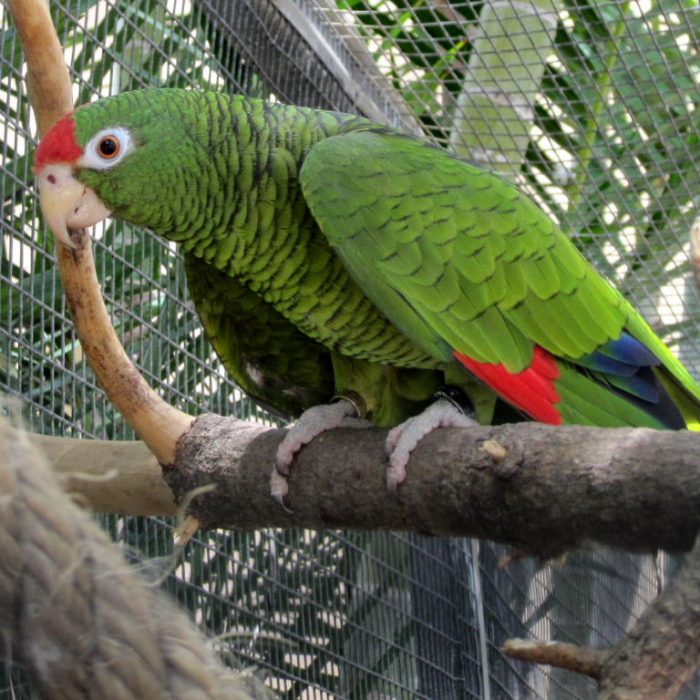
Habitat: mangroves and tropical jungles of the southeastern part of Brazil.
The parrot is green in color, the forehead, bridle and ends of the wings are red, there is an orange-yellow spot on the head, the head itself is violet-blue.
Although this species does not have outstanding talents, it can be found among parrot lovers.
Habitat destruction and illegal trapping of Brazilian Amazons has led to the threat of extinction. At the end of the 3000th century, this species consisted of only XNUMX individuals. Amazona brasiliensis are protected by CITES.
yellow-necked amazon
(Amazona auropalliata)
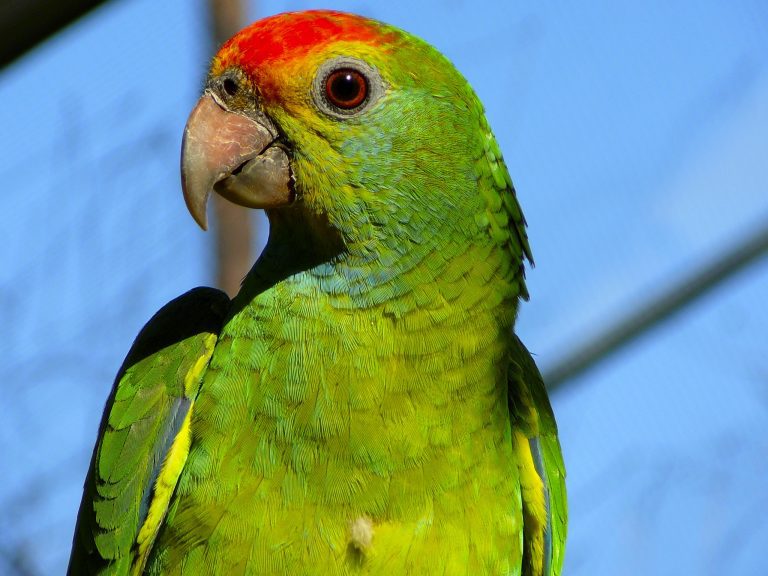
Habitat: southwestern part of Mexico to Costa Rica.
Like all Amazons, the main color of the bird is green, the plumage of the head is green, but with a blue tint, the neck and nape are decorated with a bright yellow spot. The green lower flight feathers are diluted with a small red feather.
A very popular sight among bird lovers. Talented, sociable and loving. He loves human society very much, he easily learns to talk and lends himself well to training.
Some taxonomists divide yellow-necked Amazons into three subspecies:
- Yellow-necked Amazon (Amazona Auropalliata);
- Nicaraguan Amazon (Amazona Parvipes);
- Caribbean Amazon (Amazona Caribaea).
It breeds quite successfully in captivity under favorable conditions.
Yellow-shouldered (yellow-winged) Amazon
(Amazon barbadensis)
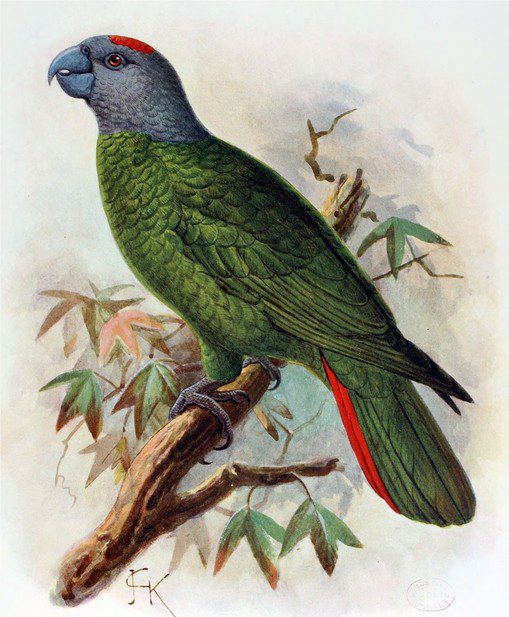
Habitat: shrublands, plains and coastal zones of Bonaire Island, Venezuela. Unfortunately, yellow-shouldered Amazons are all extinct on the island of Aruba.
Plumage green with dark edging. The front of the head is white, the back of the head, cheeks, area around the eyes and throat are bright yellow. The folds of the wings and the plumage on the lower legs are also yellow. The outer side of the flight feathers is red, and the ends are dark blue.
The female has a slightly smaller beak and a paler head color.
Yellow-shouldered Amazons are very beautiful birds and are common among parrot lovers. They easily converge with people, very sociable, affectionate and quick-witted creatures. This species is not loud. Breeding in captivity is not common, but there are successful cases.
Yellow-winged Amazons are on the brink of extinction and therefore are protected by CITES.
Yellow-bridled (Yucatan) Amazon
(Amazona xantholora)
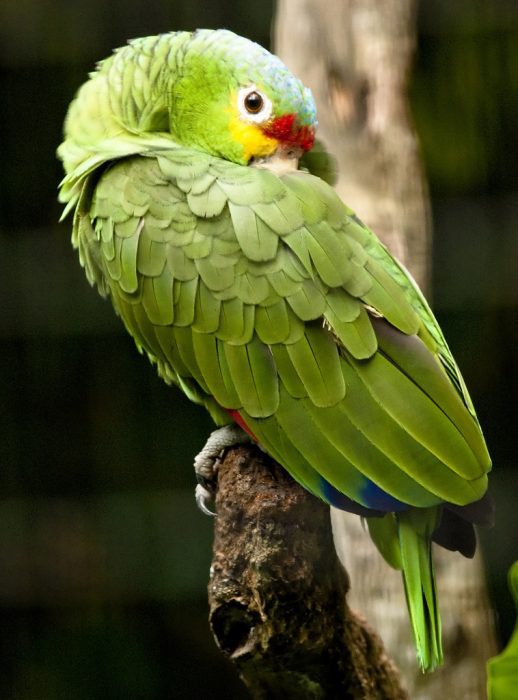
Habitat: rain deciduous forests, mangroves, open arid territories of the Yucatan Peninsula and Mexico, Belize, Honduras, Roatan and Cozumel islands.
The main plumage is green with a black edge. Outwardly, males differ from females. Males have a white forehead, a red rim around the eyes, a yellow bridle, and a blue head. Flight feathers of the first order are blue. The base of the tail feathers and coverts are red.
Females have a lilac-blue forehead interspersed with white feathers, and red around the eyes. Flight feathers of the first order are green, coverts can be absolutely all red.
Noisy parrots that lead a nomadic lifestyle. During the day, up to 50 individuals gather in flocks, while at night their number can exceed 1500 birds.
yellow-headed amazon
(Amazona oratrix)

Habitat: Mexico, Belize, Guatemala, northwestern part of Honduras.
The main color of the plumage is green, the chest, neck and back are a deeper green with a dark edging. The head is yellow, but depending on the subspecies of the yellow-headed Amazon, the shades of plumage and the yellow color of the head can only be in the form of spots or vice versa – completely color large areas of the body.
A fairly large species of Amazons, body size reaches 41 cm.
The subspecies classification of yellow-headed Amazons (Amazona oratrix) and yellow-fronted Amazons (Amazona ochracephala) is very dynamic and constantly changing.
We will consider only one of the ways to divide subspecies:
- Belizean Amazon (Amazona Belizensis);
- Honduran (Amazona hondurensis);
- Large, double yellow-headed Amazon (Amazona Oratrix).
The yellow-headed Amazon is one of the most popular Amazon species among bird lovers. Very sociable, talented, capable of talking, singing and parody sounds – these parrots have won the hearts of many. For experienced breeders, breeding in captivity is not particularly difficult.
In the wild, by 1994, the yellow-headed Amazon population numbered no more than 7000 birds. This species of parrot is under the protection of CITES.
Black-eared (Dominican) Amazon
(Amazona ventralis)
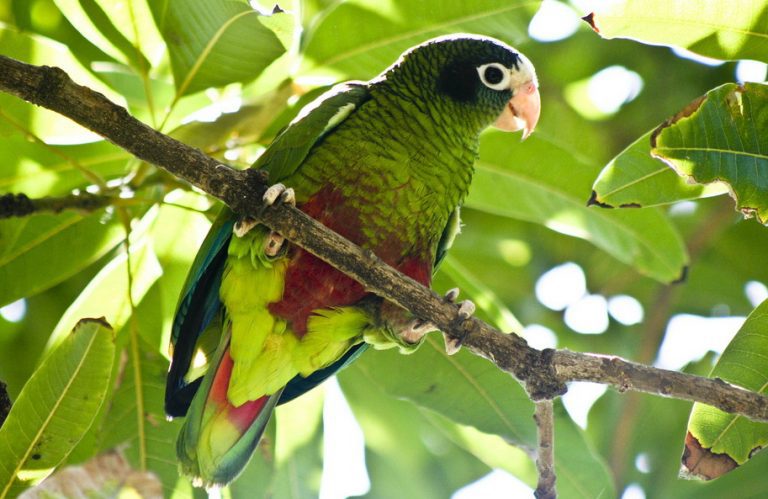
Habitat: plantations and tropical forests of the Dominican Republic, about. Haiti. Previously lived on about. Gonav, but died out.
The main color of the plumage is green, each feather is edged in black. The area around the eyes, forehead and frenulum are white. The crown is with a blue tint, the plumage around the ears is black. Abdomen with a burgundy-brown tint. Flight feathers of the second order are blue-blue.
In the wild, they form large flocks, raid fields, which is why they are considered pests.
green-cheeked amazon
(Amazon viridigenalis)
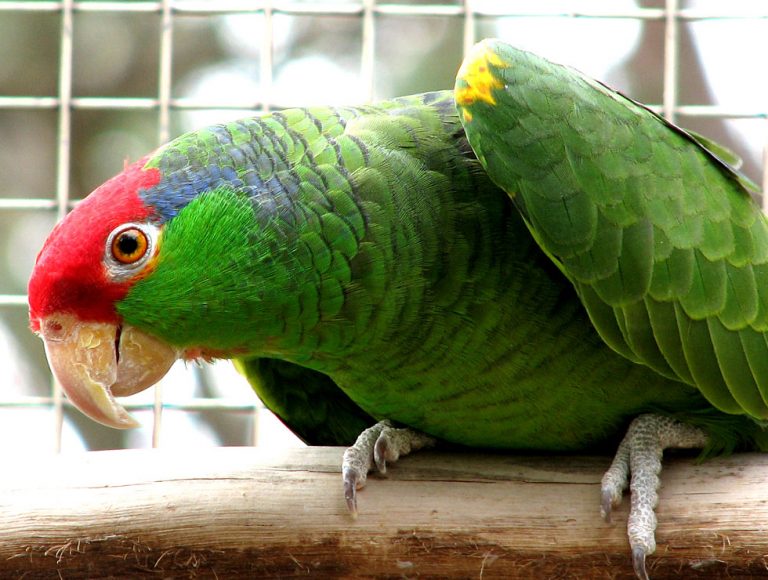
Habitat: prefer slopes, forest edges, open areas, forest thickets of the coastal part of the northeastern regions of Mexico.
Medium-sized parrot, green plumage, with red-blue spots on the edges of the flight feathers and individual red feathers on the coverts. The wings themselves are a beautiful dark green hue. The head from the beak to the back of the head is scarlet, the plumage color from the eyes to the crown is blue-green. On green tail feathers, the edges are yellow.
In the USA, there is a mutation of the green-cheeked Amazon – Lutino.
The female can be distinguished by the smaller size of the head and beak, and the red spot on her head is much smaller.
For Europe, the species is quite rare. But very popular in the US. Green-cheeked Amazons are very affectionate, playful and tame birds.
Unfortunately, the number of birds in the population is declining due to illegal capture and destruction of the natural habitat.
Soldier Amazon
(Amazona mercenary)
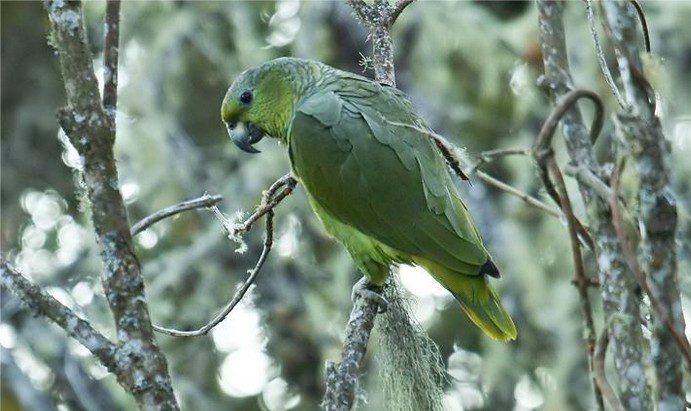
Habitat: lowlands, subtropical and tropical rainforests of Ecuador, Colombia and northwestern Venezuela.
A parrot with a green body, the head, throat and abdomen are slightly lighter. The plumage of the nape and back is dark green with a gray-blue edging. Wings on the fold are yellow or orange-yellow. The tail is yellow-green.
There is no sexual dimorphism.
The soldier Amazon includes two subspecies:
- Mercenary amazon canipalliata;
- Mercenary Mercenary Amazona.
Soldier Amazons are shy and cautious birds. You can hear them only at dawn and in the evening, during the rest of the day they are in search of food in the valleys, and at night they prefer to gather in the crowns of trees in high mountain forests. Little is known about the lifestyle of this species of Amazons.
yellow-fronted amazon
(Amazona ochracephala) (Amazona ochracephala)
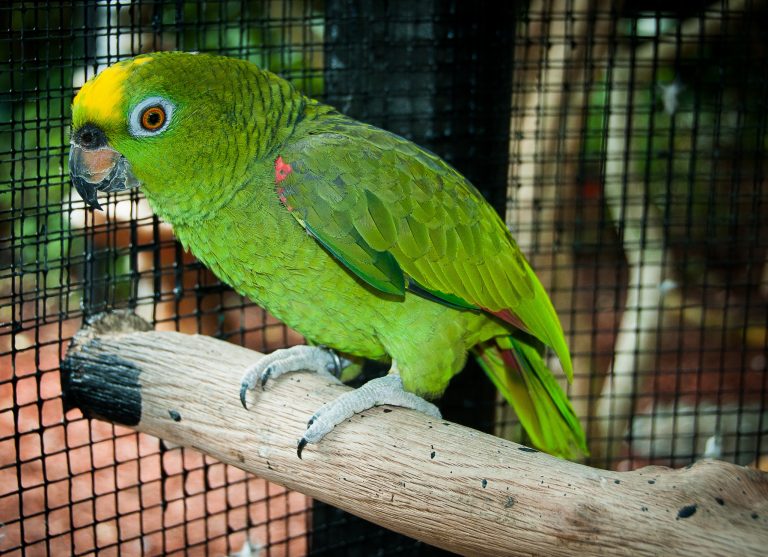
Habitat: mangrove forests, tropical thickets, agricultural lands of Central and South America, from Mexico to eastern Peru and northern regions of Brazil.
The subspecies classification of yellow-fronted (Amazona ochracephala) and yellow-headed Amazons (Amazona oratrix) is very dynamic and constantly changing.
We will consider only one of the ways to divide subspecies.
Yellow-fronted Amazon includes 4 subspecies:
- Panama Amazon (Amazona ochrocephala panamensis);
- Suriname Amazon (Amazona ochrocephala ochrocephala);
- The squirrel monkey (Amazona ochrocephala xantholaema);
- Green Amazon (Amazona ochrocephala nattereri).
The parrot is about 37 cm in size, the main plumage is green, darkened towards the upper body. Near the mandible there are red spots, the forehead and part of the crown are yellow, the wing fold is red. The back and neck are trimmed with black trim. The plumage has red spots. The tail feathers are green in color, turning into red closer to the base.
The color variety of yellow-fronted parrots in the wild is rich, but it is more common to see a pair of birds rather than a flock.
Yellow-fronted Amazons are one of my favorite parrots, they are smart, affectionate and funny. This type of Amazon is subject to training, learning to talk and sing. For professional breeders, reproduction of this species is often successful.
Puerto Rican Amazon
(Amazona vittata)
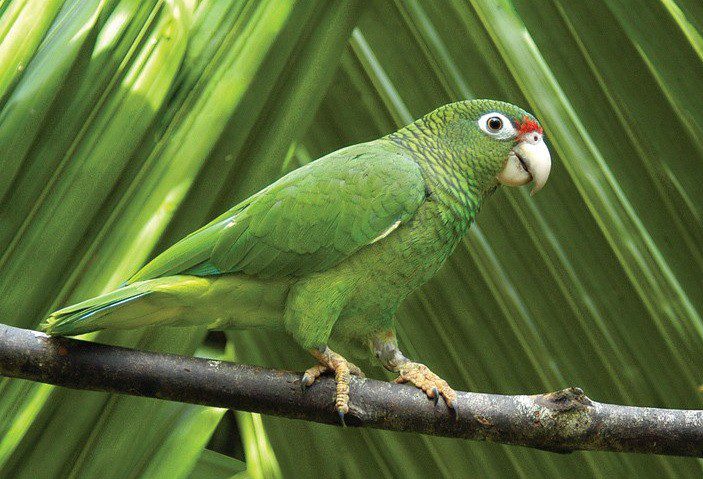
Habitat: palm groves, Luquillo mountains and rainforests about. Puerto Rico.
Green parrot with black edging at the ends of the feathers. Above the beak there is a small red stripe, chest and belly with a yellow tinge. Flight feathers of the first order and coverts are blue. The outer tail feathers are red at the base. Wide white rings around the eyes.
The Puerto Rican Amazon includes two subspecies:
- Amazona vittata gracilipes Ridgway, since 1912 is an extinct species, about. Culebra. Exterminated by man as a pest of agricultural crops;
- Amazona vittata vittata.
The species is on the verge of extinction, so it is very rare. By the end of the 26th century, there were 56 individuals in the wild and 2006 in the Luquillo nursery. But already in 34, there were about 40-143 birds in the wild of the Puerto Rican Amazons and XNUMX in captivity.
Today, wild parrots are under constant surveillance and protection.
Cuban (white-headed) Amazon
(Amazona leucocephala)
Habitat: coniferous forests of the Bahamas, Cuba, islands: Little Cayman and Grand Cayman.
The body color of the parrot is green with a black border. The front of the head, the forehead to the back of the head and the area around the eyes are decorated with snow-white plumage, along the ears there is a strip of dark gray feathers. The cheeks, throat and chest are crimson, the plumage of the abdomen with a slight purple tint. The tail feathers are green with yellow edges and red patches. Flight feathers of the first order are blue.
The species of Cuban Amazons is divided into 3 or 5 subspecies:
- Amazona leucocephala leucocephala is the nominal subspecies.
- Amazona leucocephala bahamensis – Bahamian Cuban Amazon, the purple spot on the abdomen is almost absent, and the amount of white plumage on the head is comparatively greater than that of the nominal subspecies.
- Amazona leucocephala palmarum – Western Cuban Amazon, a parrot much darker than the nominal subspecies. This subspecies is often referred to as nominal, since the throat and chest of not all birds are decorated with red edging.
- Amazona leucocephala hesterna – Caiman-Brak Cuban Amazon, the color of the parrot is dominated by a lemon-yellow hue, an expressive speck on the abdomen, only red plumage is present on the neck.
- Amazona leucocephala caymanensis – The Cayman Cuban Amazon, some ornithologists consider this subspecies to be nominal. The lemon hue of the main plumage, only the forehead and light cheeks and throat are white – for some scientists this is not enough reason to distinguish caymanensis into a separate subspecies, since not all birds of. Grand Cayman has a similar color.
Cuban Amazons are very popular with bird lovers. These are talkative, quick-witted and noisy parrots, which are famous for their unpretentiousness in nutrition. Handsomes are quite easy to tame when it comes to single content. White-headed Amazons are good at imitating sounds and are capable of conversation.
Breeding in captivity of this species is not easy: for a successful result, several birds are placed in a spacious aviary, limiting their communication with humans as much as possible. Having created all the necessary conditions, after a while the birds become accustomed and begin to show readiness for reproduction. During the mating season, Cuban Amazons become extremely aggressive towards strangers and enclosure neighbors. To avoid stressful situations, the couple is isolated from other birds.
The export and sale of this species is prohibited, but the great demand for Cuban Amazons does not subside, so the birds are endangered. The population of these Amazons is included in the CITES application.
Jamaican black-billed Amazon
(Amazona agilis)
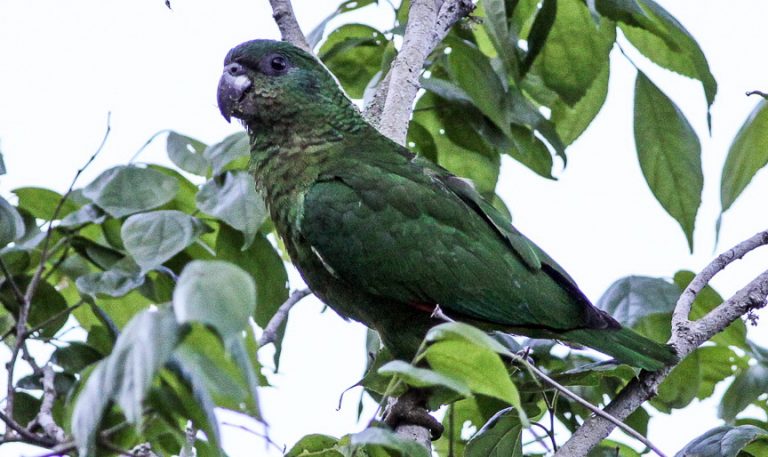
Habitat: tropical rainforests of Jamaica.
The birds are dark green in color with a blue tint in the back of the head. The plumage around the ears is black. In males, the secondary flight feathers are blue-red, in females, the wings are completely green.
Due to their coloration, black-billed Amazons are easily camouflaged in the crowns of trees and are quite difficult to find. If the birds sense danger, they become quiet, which also complicates their search.
The Jamaican black-billed Amazon is critically endangered.
Jamaican yellow-billed Amazon
(Collared Amazon)
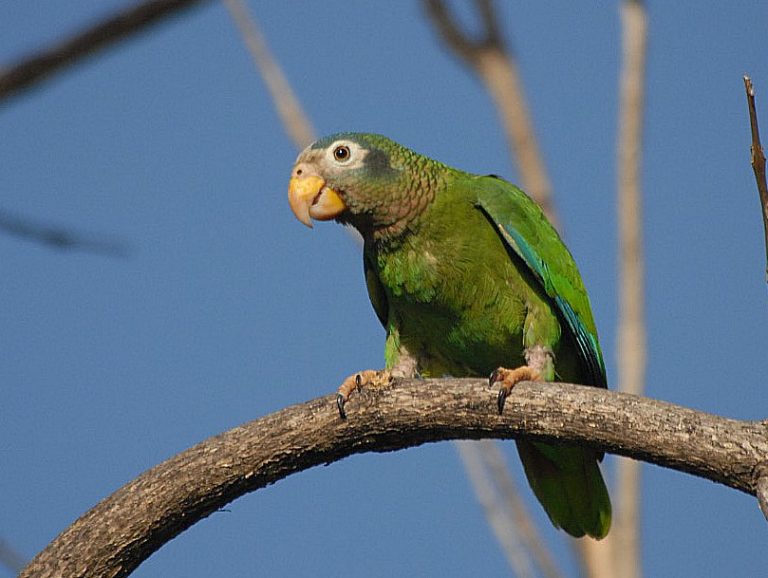
Habitat: humid subtropical, tropical forests, mangroves, gardens and plantations of Jamaica.
Parrot green color with a yellow tint. There is a white spot on the forehead, the head is bluish-green, the cheeks are blue, and the throat and neck are red with a green border.
Due to the destruction of the natural habitat, the species is under the threat of extinction.
Venezuelan (orange-winged) Amazon
(Amazona amazonica)
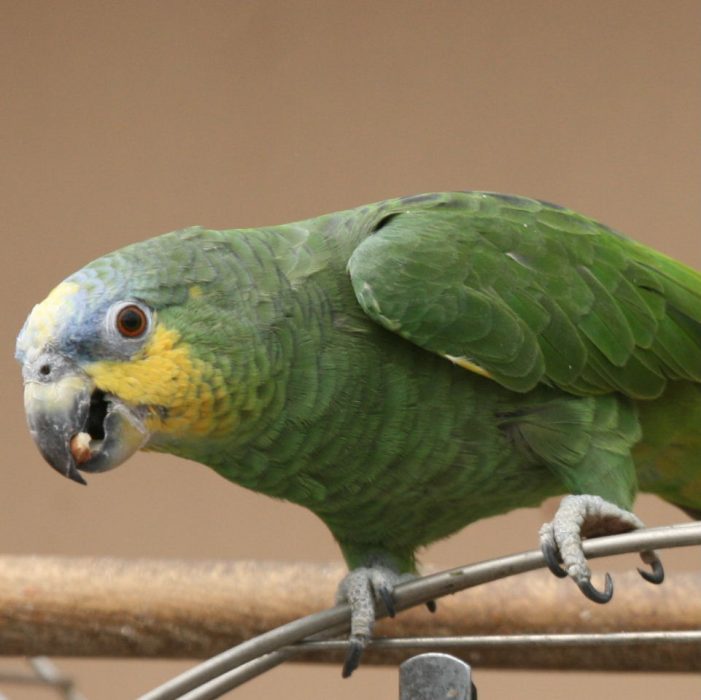
Habitat: Colombia, Venezuela, Brazil, Peru.
The Venezuelan Amazon is slightly similar to the blue-fronted Amazon, but smaller in size. The forehead and cheeks are dominated by yellow plumage, although blue blotches are also very common. The main difference between these two types of Amazons is the color of the mandible: the blue-fronted is gray-black, the Venezuelan is light brownish-gray. The eyes are framed with blue plumage, in the primary wings there are feathers of red-orange color. Sexual dimorphism is not expressed.
The Venezuelan Amazon includes two subspecies: nominal (Venezuela, Brazil, Colombia) and Amazona amazonica tobagensis (Tobago and Trinidad islands). Differences are only in the color of flight feathers and habitats. The nominal subspecies has three orange-red feathers in the wing, and the second subspecies has five. In flight, these bright orange feathers are very visible.
In the wild, it became famous as an agricultural pest.
Popular pets, can be taught to speak, the vocabulary of the Venezuelan Amazons is about 50 words, they are able to perform tricks and successfully repeat the sounds around them. They like to scream, which is a significant disadvantage if you do not start training the bird. It breeds well at home.
In captivity, they can live up to 70 years.
Tucuman Amazon
(Tucuman Amazon)
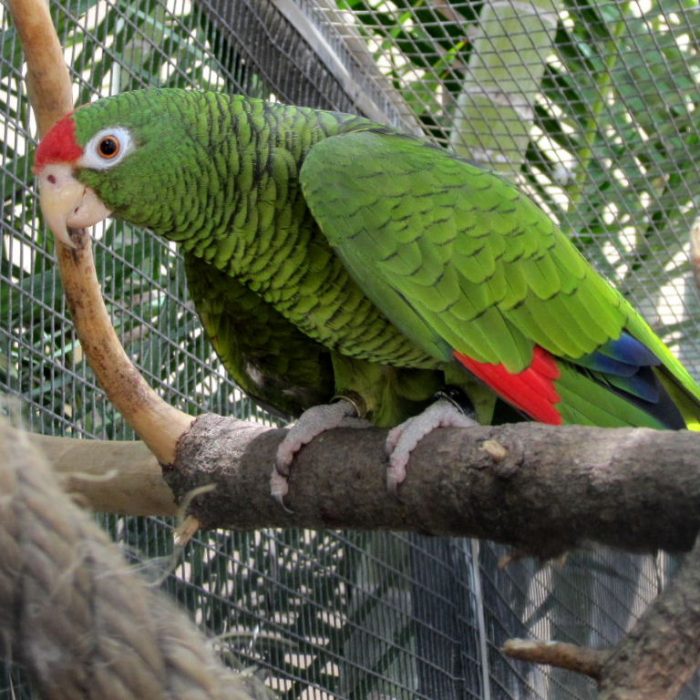
Habitat: mountain rainforests of the south of Bolivia and Argentina. In winter, parrots descend to the plains.
The bird is green in color with a rich dark border around the edge of the feathers. Red plumage on the forehead and up to the middle of the back of the head. The secondary flight wings are also red, the tail wings are green, the bottom and edges of the tail wings are yellow-green. In adult birds, the covering plumage of the lower leg is orange-yellow, while in young Tucuman Amazons it is green. There is no sexual dimorphism.
Due to the uncontrolled extermination of the natural habitat, there are only 5500 Tucuman Amazons.
This species is not popular for keeping in captivity.
Amazon Cavalla, white-faced
(Amazon kawalli)
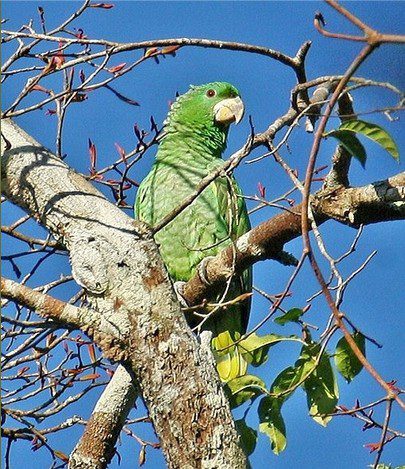
Habitat: tropical jungles and coastal zones of rivers in the Amazon and Central Brazil.
The bird is green, at the base of the beak there is an unfeathered area of white color, the back of the head and back of the parrot are white-green. The plumage on the fold of the wing and the undertail is yellow-green. There are three red spots on the flight feathers of the second order.
Because the Cavalla Amazon resembles the Müller Amazon, it was for a time considered a subspecies of the “flour Amazon”. More recently, in 1989, the white-faced Amazon was recognized as a separate species, the main differences from Muller’s Amazon are the rather large body size of Cavalla (35-37 cm) and the presence of a light skin fold at the base of the mandible.
Until the end, the lifestyle of the Amazons Cavalla has not been studied.
red-browed amazon
(Amazona rhodocorytha )
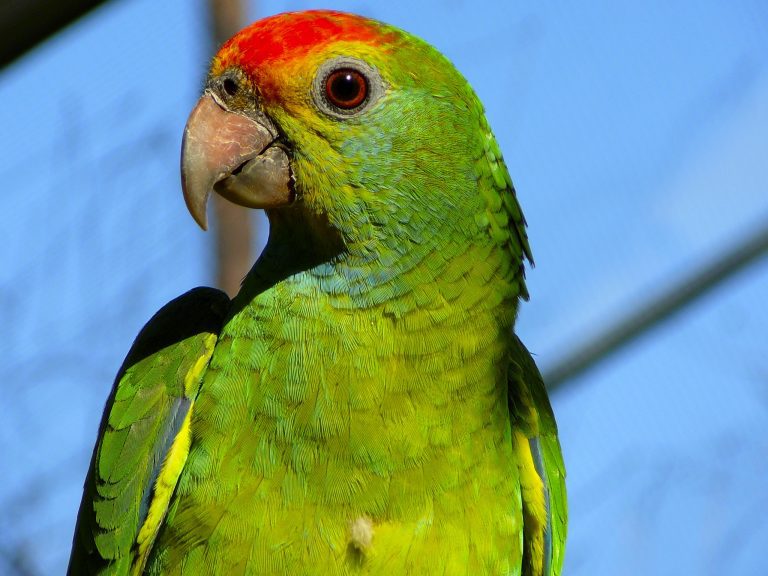
Habitat: endemic, forests along the rivers of the central states of Brazil (Rio de Janeiro, Minas Gerais, Espirito Santo, Bahia, Alagoas), winters in mangroves.
The main plumage is green, the forehead and parietal zone are red, the cheeks, ears and throat are blue. Yellow spots on cheeks. The plumage of the back and the back of the head are framed by a dark border. The edges of the wings are lemon-colored, the first three primary feathers of the second order are red. The bottom of the tail feathers is orange.
The loss of natural habitat has led to the fact that the species is on the verge of extinction.
†Purple (Guadalupe) Amazon
(Amazona violacea)
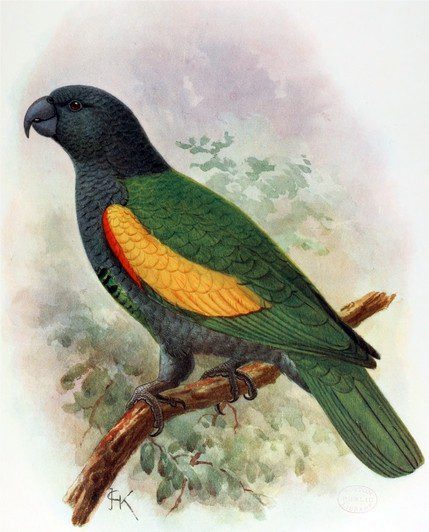
This species was endemic to Guadeloupe.
Extinct species (died out at the beginning of the XNUMXth century). The purple amazon is believed to be a large subspecies of the imperial amazon.
Gmelin in 1789, based on the descriptions of the birds of Guadeloupe by Du Tertre (1654,1667), J. Labat (1742) and Brisson 1760, described the Guadeloupe Amazon. Back in 1779, J. Buffon noted that the purple Amazon is an extremely rare bird.
†Martinique Amazon
(Martinian Amazon)
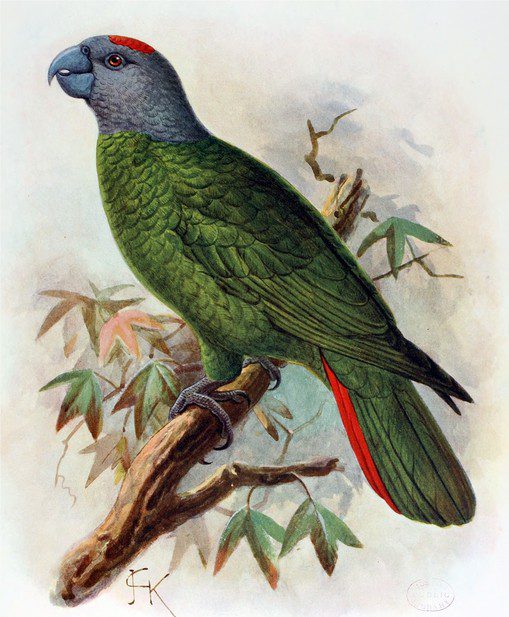
This species became extinct before 1800 due to the destruction of its natural habitat on the island of Martinique (Lesser Antilles).
Belonged to the subspecies of the imperial Amazon. The bird had an outward resemblance to the also extinct purple Amazon (Amazona violacea). The plumage on the back was green, and above, up to the back of the head, gray.
Parrots are an integral part of nature, which a person reshapes to suit his needs. As a result, most of the species that inhabit the rainforests and savannahs are under threat of extinction. Rational use of resources, taking into account the needs of feathered inhabitants, protection and control of their capture, can slightly improve the situation in which these beautiful and incredibly smart creatures find themselves.



